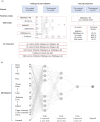Artificial intelligence to predict in-hospital mortality using novel anatomical injury score
- PMID: 34876644
- PMCID: PMC8651670
- DOI: 10.1038/s41598-021-03024-1
Artificial intelligence to predict in-hospital mortality using novel anatomical injury score
Abstract
The aim of the study is to develop artificial intelligence (AI) algorithm based on a deep learning model to predict mortality using abbreviate injury score (AIS). The performance of the conventional anatomic injury severity score (ISS) system in predicting in-hospital mortality is still limited. AIS data of 42,933 patients registered in the Korean trauma data bank from four Korean regional trauma centers were enrolled. After excluding patients who were younger than 19 years old and those who died within six hours from arrival, we included 37,762 patients, of which 36,493 (96.6%) survived and 1269 (3.4%) deceased. To enhance the AI model performance, we reduced the AIS codes to 46 input values by organizing them according to the organ location (Region-46). The total AIS and six categories of the anatomic region in the ISS system (Region-6) were used to compare the input features. The AI models were compared with the conventional ISS and new ISS (NISS) systems. We evaluated the performance pertaining to the 12 combinations of the features and models. The highest accuracy (85.05%) corresponded to Region-46 with DNN, followed by that of Region-6 with DNN (83.62%), AIS with DNN (81.27%), ISS-16 (80.50%), NISS-16 (79.18%), NISS-25 (77.09%), and ISS-25 (70.82%). The highest AUROC (0.9084) corresponded to Region-46 with DNN, followed by that of Region-6 with DNN (0.9013), AIS with DNN (0.8819), ISS (0.8709), and NISS (0.8681). The proposed deep learning scheme with feature combination exhibited high accuracy metrics such as the balanced accuracy and AUROC than the conventional ISS and NISS systems. We expect that our trial would be a cornerstone of more complex combination model.
© 2021. The Author(s).
Conflict of interest statement
The authors declare no competing interests.
Figures


References
-
- Moore EE, Feliciano DV, Mattox KL. Trauma. 8. McGraw-Hill Education; 2017.
Publication types
MeSH terms
LinkOut - more resources
Full Text Sources
Medical

